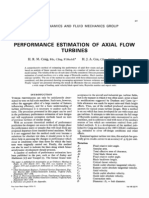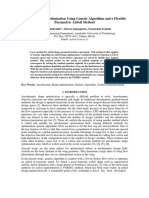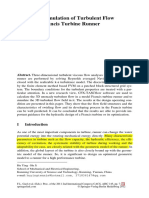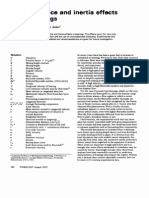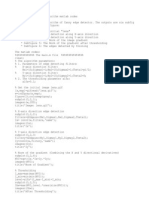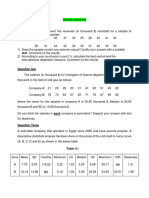Génie Mécanique: Institute of Mechanical Engineering
Uploaded by
Mourad TargaouiGénie Mécanique: Institute of Mechanical Engineering
Uploaded by
Mourad TargaouiInstitute SECTION DEof
LFMI
2aborator$ of fluid mechanics and instabilities
Gnie mcanique Mechanical Engineering
2aboratoire de conce tion de LCSM s$st3mes Laboratoire de Conception de Systmes Mcaniques m4cani+ues
Numerical study of herringbone grooved ournal air bearings
Yoan Marchand
%& Introduction
A Herringbone Grooved Journal Bearing (HGJB) is com osed of a grooved rotating art! and a fi"ed smooth su ort. #he load is transferred due to the eccentricit$.
'& (esults
#he resolution is firstl$ done in t%o dimensions (grooves arallel to the a"is of rotation). #he s ectral method and FD& are less accurate near the border of a groove. #he time of calculation is ver$ long %ith Fluent. #he FD& is im lemented in three dimensions to be com ared to the e" erimental results. #he more accurate F'& %ould also be im lemented %ith more time available. #he (arro% Groove #heor$ ((G#)! used for com arison! %as develo ed for bearings %ith infinite number of grooves and little load. #he )D results for the finite difference method are better than the ones of the (G#. An error is still resent bet%een the e" eriment and the solution of the FD&. #his error might be due to the a ro"imation on the film thic*ness. #he F'& results are needed to confirm this su osition.
)& *otivation and ob ectives
Different theories have been develo ed to com ute the ressure field around the bearing. #hese methods are based on the lubrication e+uation. #he$ are not validated %ith e" erimental results for small number of grooves or high loading due to a la*e of e" eriments for these conditions. /ne ob0ective is to develo some of these theories and validate them %ith recent e" erimental results. #he goal of this recent e" erimental contribution %as to com lete the literature %ith results for high loading and small number of grooves. Another ob0ective is to chec* if it is ossible to model the roblem %ith a commercial soft%are solving the (avier1Sto*es e+uations. #his %ould give more accurate results. An investigation on the influence of the sha e of a groove is also leaded. #his influence is im ortant since the real sha e of a groove de ends on the manufacturing rocedure. #he results of the sha es of a groove are obtained %ith the F'& in ,D. #he influence of the sha e is on the order of )5 of the force. #his results should be chec* in )D since other effects ma$ be relevant.
+& *ethods
Fluent is used as the commercial soft%are. an unstead$ solution must be found because of the combination of eccentricit$ and grooves! . a lot of cells are re+uired due to a ver$ thin film of fluid com ared to its %idth. #he lubrication e+uation is numericall$ solved %ith the finite difference method (FD&)! the s ectral method and the finite element method (F'&). #he characteristics of the s ectral method and FD& are. the film thic*ness must be smoothed near the border of each groove because this +uantit$ is differentiated! . thus the mesh must be thin to have an accurate result. #he characteristics of the finite element method are. the elements are laced either on a groove or on a ridge! so the film thic*ness must not be a ro"imated! . s ecial sha e functions are used! the$ are locall$ solution of the lubrication e+uation! . a coarser mesh can be used. Sha e >deal 9 , '" erimental Force! F @(B 6).=8 66.<, 6,.:8 6).79 Attitude angle! ? @AB 6.78 6.7; 6.7) 6.78
,& Conclusion
#he commercial soft%are cannot be used to calculate the ressure field around a bearing because that %ould ta*e to much time. #he solution of the lubrication e+uation b$ finite difference method is good even if an error subsist. #he results b$ F'& are better in ,D and should be im lemented in )D. #he results obtained %ith the e" erimental sha e are close to the one of an ideal sha e. And the ressure field is not greatl$ influenced b$ the groove sha e in ,D.
Su!ervisor
"c#no$ledgements
Prof. Francois Gallaire Dr. Alain Schorderet
Prof. Francois Gallaire Dr. Alain Schorderet
You might also like
- Performance Estimation of Axial Flow Turbines100% (2)Performance Estimation of Axial Flow Turbines34 pages
- ICS141: Discrete Mathematics For Computer Science INo ratings yetICS141: Discrete Mathematics For Computer Science I16 pages
- Dry Film Thickness Measurement ProcedureNo ratings yetDry Film Thickness Measurement Procedure5 pages
- The Measurement of Dry Film Thickness of Coatings On Structural Steelwork (Abrasive Blast Cleaned) TP913No ratings yetThe Measurement of Dry Film Thickness of Coatings On Structural Steelwork (Abrasive Blast Cleaned) TP9135 pages
- Numerical Analysis of Tuned Liquid Dampers For Structural Vibration ControlNo ratings yetNumerical Analysis of Tuned Liquid Dampers For Structural Vibration Control42 pages
- Diffuser Development For A Diffuser Augmented Wind Turbine Using Computational Fluid DynamicsNo ratings yetDiffuser Development For A Diffuser Augmented Wind Turbine Using Computational Fluid Dynamics16 pages
- Investigation of Effect of Nozzle Geometry On SpraNo ratings yetInvestigation of Effect of Nozzle Geometry On Spra11 pages
- A Simple Semiempirical Short-Channel MOSFET Current-Voltage Model Continuous Across All Regions of Operation and Employing Only Physical ParametersNo ratings yetA Simple Semiempirical Short-Channel MOSFET Current-Voltage Model Continuous Across All Regions of Operation and Employing Only Physical Parameters13 pages
- Dynamic Model Identification For Industrial Robots: Ngoc Dung Vuong, Marcelo H. Ang JRNo ratings yetDynamic Model Identification For Industrial Robots: Ngoc Dung Vuong, Marcelo H. Ang JR7 pages
- Computational Fluid Dynamics For Turbo Machinery DesignNo ratings yetComputational Fluid Dynamics For Turbo Machinery Design19 pages
- Navier - Stokes Optimization Using Genetic Algorithm and A FlexibleNo ratings yetNavier - Stokes Optimization Using Genetic Algorithm and A Flexible7 pages
- CFD Analysis of Screw Compressor Performance: Ahmed Kovacevic, Nikola Stosic and Ian K. SmithNo ratings yetCFD Analysis of Screw Compressor Performance: Ahmed Kovacevic, Nikola Stosic and Ian K. Smith28 pages
- Advanced Search: 1 Contour Method Techniq Ue ReviewNo ratings yetAdvanced Search: 1 Contour Method Techniq Ue Review10 pages
- AASHTO LRFD 2012 BridgeDesignSpecifications 6th Ed (US)No ratings yetAASHTO LRFD 2012 BridgeDesignSpecifications 6th Ed (US)33 pages
- 7 - SPE-29312-MS - Inflow Performance Relationship For Perforated Wells PDFNo ratings yet7 - SPE-29312-MS - Inflow Performance Relationship For Perforated Wells PDF6 pages
- Optimization of Turbo Machinery Validation Against Experimental ResultsNo ratings yetOptimization of Turbo Machinery Validation Against Experimental Results13 pages
- RCS Characterization of A Finite Ground Plane With Perforated Apertures: Simulations and MeasurementsNo ratings yetRCS Characterization of A Finite Ground Plane With Perforated Apertures: Simulations and Measurements11 pages
- Advanced Computational Modeling for Estimating Safe Cuttings Load Cutting and CFDNo ratings yetAdvanced Computational Modeling for Estimating Safe Cuttings Load Cutting and CFD13 pages
- 2015, Investigating The Effect of Cable Force Wich Windign Accuracy For Cable-DrivenNo ratings yet2015, Investigating The Effect of Cable Force Wich Windign Accuracy For Cable-Driven9 pages
- Buckling Analysis in 3D Warp Validation ReportNo ratings yetBuckling Analysis in 3D Warp Validation Report9 pages
- Fcs Response To The Radiocommunications Agency 450-470Mhz Band Alignment Consultation Document (December 2002)No ratings yetFcs Response To The Radiocommunications Agency 450-470Mhz Band Alignment Consultation Document (December 2002)12 pages
- Chapter-5_e520938a-7e0f-4500-8035-2c357f17270eNo ratings yetChapter-5_e520938a-7e0f-4500-8035-2c357f17270e30 pages
- Salcedoss@inta - Es Mongef@inta - Es Palaciosg@inta - Es Fgandia@upm - Es Angel - Rodriguez.sevillano@upm - EsNo ratings yetSalcedoss@inta - Es Mongef@inta - Es Palaciosg@inta - Es Fgandia@upm - Es Angel - Rodriguez.sevillano@upm - Es7 pages
- Effects of Porosity On Mechanical Properties of Aluminum WeldsNo ratings yetEffects of Porosity On Mechanical Properties of Aluminum Welds15 pages
- ITTC - Recommended Procedures and Guidelines: Practical Guidelines For Ship CFD ApplicationsNo ratings yetITTC - Recommended Procedures and Guidelines: Practical Guidelines For Ship CFD Applications18 pages
- Design Sensitivity Analysis of Air-Lubricated Slider BearingsNo ratings yetDesign Sensitivity Analysis of Air-Lubricated Slider Bearings3 pages
- Multi-Objective Optimization of A Hypersonic Inlet Using Generalized Outflow Boundary Conditions in The Continuous Adjoint MethodNo ratings yetMulti-Objective Optimization of A Hypersonic Inlet Using Generalized Outflow Boundary Conditions in The Continuous Adjoint Method25 pages
- Numerical Simulation of Turbulent Flow Through A Francis Turbine RunnerNo ratings yetNumerical Simulation of Turbulent Flow Through A Francis Turbine Runner6 pages
- Mathematical Analysis of Quasi-Simultaneous Laser Welding on PolymersFrom EverandMathematical Analysis of Quasi-Simultaneous Laser Welding on PolymersNo ratings yet
- Introduction to Optical Waveguide Analysis: Solving Maxwell's Equation and the Schrödinger EquationFrom EverandIntroduction to Optical Waveguide Analysis: Solving Maxwell's Equation and the Schrödinger EquationNo ratings yet
- Tous Actualités Maps Vidéos Plus Paramètres Outils: ImagesNo ratings yetTous Actualités Maps Vidéos Plus Paramètres Outils: Images3 pages
- Turbulence and Inertia Effects in BearingsNo ratings yetTurbulence and Inertia Effects in Bearings7 pages
- An Exact Analytical Solution of The Reynolds Equation For The Finite JournalNo ratings yetAn Exact Analytical Solution of The Reynolds Equation For The Finite Journal13 pages
- Wear, 44 (1977) 329: 343 0 Elsevier Sequoia S.A., Lausanne - Printed in The NetherlandsNo ratings yetWear, 44 (1977) 329: 343 0 Elsevier Sequoia S.A., Lausanne - Printed in The Netherlands15 pages
- Tribology International: Shih-Kang Chen, Hsien-Chin Chou, Yuan KangNo ratings yetTribology International: Shih-Kang Chen, Hsien-Chin Chou, Yuan Kang14 pages
- 2023-Analysis of Software Effort Estimation by Machine Learning TechniquesNo ratings yet2023-Analysis of Software Effort Estimation by Machine Learning Techniques14 pages
- Face Recognition Based On Convolutional Neural Network.: November 2017No ratings yetFace Recognition Based On Convolutional Neural Network.: November 20175 pages
- Study On Machine Learning Research PaperNo ratings yetStudy On Machine Learning Research Paper17 pages
- (PDF Download) Using R and RStudio For Data Management Statistical Analysis and Graphics 2nd Edition Nicholas J. Horton Fulll Chapter100% (6)(PDF Download) Using R and RStudio For Data Management Statistical Analysis and Graphics 2nd Edition Nicholas J. Horton Fulll Chapter49 pages
- Feedback Control System and Its Advantages: Submitted BY: Submitted TONo ratings yetFeedback Control System and Its Advantages: Submitted BY: Submitted TO7 pages
- Canny Edge Detector Algorithm Matlab CodesNo ratings yetCanny Edge Detector Algorithm Matlab Codes2 pages
- Detection and Analysis of AD Using Various MachineNo ratings yetDetection and Analysis of AD Using Various Machine26 pages
- Lecture 21 Lead Lag Compensator Design-2021-AE 308 AE 775-AMNo ratings yetLecture 21 Lead Lag Compensator Design-2021-AE 308 AE 775-AM54 pages
- Direct Control and Coordination Using Neural Networks: AbstractNo ratings yetDirect Control and Coordination Using Neural Networks: Abstract12 pages
- 20220910171232HCTAN008C8-Topic 8-Risk ReturnNo ratings yet20220910171232HCTAN008C8-Topic 8-Risk Return105 pages
- Simple Particle Swarm Optimization For Solving BeaNo ratings yetSimple Particle Swarm Optimization For Solving Bea8 pages
